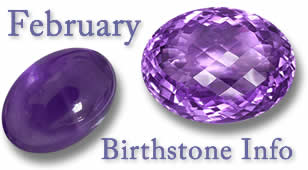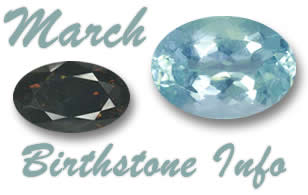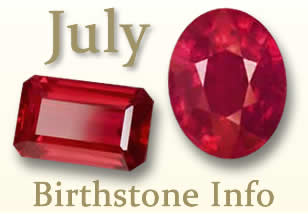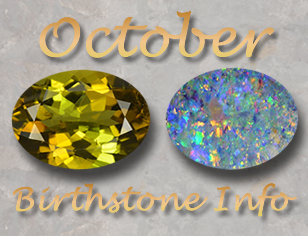What can I find in this article?
- What are the November birthstones?
- What is the color of the November birthstones?
- History of the November birthstones
- What is the meaning of the November birthstones?
- The healing properties of the November birthstones
- What is the durability of the November birthstones?
- Cleaning and Caring for November birthstones
- How much do November birthstones cost?
- Are there any secondary November birthstones?
- Final Thoughts
Citrine and Topaz - the November Birthstones
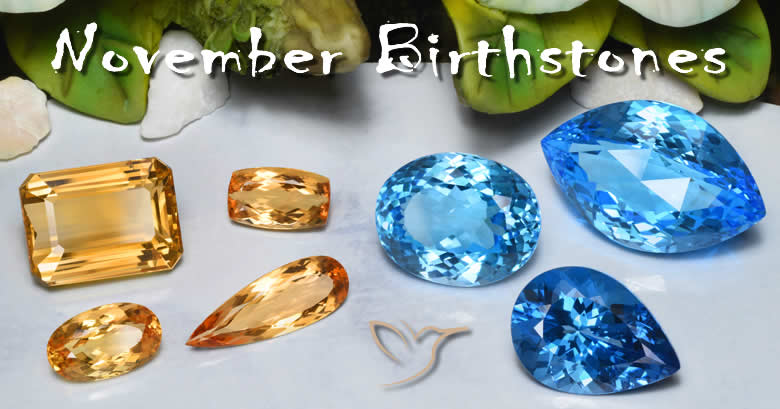
The term "birthstone" refers to gems which are related to any specific birth month, and each of these stones has its own historical significance, meaning and healing properties. If you ask someone about their birthstone, they usually seem to know the answer. Birthstones are used in various types of jewelry, such as bracelets, necklaces, earring or rings, and help to remind us of some special occasions in our birth month.
Birthstones have become a significant aspect of modern culture, with a long-standing belief dating back to ancient times that wearing them can bring good health, fortune, and various other advantages. In this article, we will explore the November birthstone options and delve into the positive attributes linked to them.
As many as two significant birthstones are considered to be November birthstones, namely topaz and citrine.
These are also the Sagittarius zodiac stones (23rd Nov to 21st Dec). Topaz is an energetic birthstone that is available in a variety of colors, ranging from intense orange to red and blue, while citrine is available in tones ranging from pale yellow to brownish red.
You can present either of these birthstones to someone who is born in the month of November and they will be delighted. By doing this, you will prove yourself to be a thoughtful and sensible person who has given lots of thought to choosing one of these wonderful items. This can be a boon to your relationship and bring you closer to the person you care for.
As mentioned earlier, topaz is a versatile birthstone, which can vary in color from champagne to orange, yellow, pink, red, and blue, but pure topaz is colorless and is often used as a diamond substitute. The yellow variety of topaz that was available in ancient Egypt was believed to be an embodiment of Ra, the Sun God, due to the intensely vibrant color. As a result, you will find topaz in quite a few ancient Egyptian talismans and other artifacts.
We often tend to confuse topaz with quartz thanks to their identical colors. While, it is quite natural to mistake champagne-colored topaz for Smokey Quartz with the naked eye, it is not difficult to differentiate between these two minerals, thanks to contemporary gemological testing methods. Furthermore, topaz is a pleochroic mineral, which means that it can show different colors when viewed from different angles.
Topaz can commonly be found in an attractive blue shade; a special irradiation treatment is used to alter colorless topaz to a bright blue. This treatment is widely accepted nowadays and it can be taken for granted that a great deal of the affordable blue topaz on the market has gone through this treatment.
You will come across a couple of popular varieties of this November birthstone on the market, namely Imperial Topaz and Precious Topaz. Imperial Topaz was originally obtained in Russia in the form of an orange crystal with red dichroism, (this means that when tilted in the light, Imperial Topaz can appear red or orange), though today it is more widely defined as yellow, pink, red, lavender-pink and peach-pink, and is primarily found in Brazil, along with Precious Topaz, an intensely yellow variety of topaz. Currently, both of these varieties can be quite pricey as compared to other types of topaz.
Due to the lack of naturally colored blue topaz gemstones, the colorless variety is usually subjected to irradiation to transform it to different shades of blue.
As many as three irradiation procedures are employed:
- exposing the topaz to gamma rays within an irradiator made of cobalt
- bombarding it with electrons within an accelerator
- bombarding it with neutrons within a nuclear reactor.
Vendors make use of terms such as Swiss Blue, London Blue, Super Blue, and Maxi Blue for the purpose of describing these darker blue shades achieved through irradiation, and Sky Blue for describing the lighter shades. Generally speaking, the price of the darker blues is going to be higher than the paler tones; however, both of them are usually affordable.
Another common topaz treatment is the creation of pink topaz, achieved by heating yellow topaz. Heat treatment, as well as irradiation, are both permanent in the long run. On most occasions, they are not detectable whatsoever.
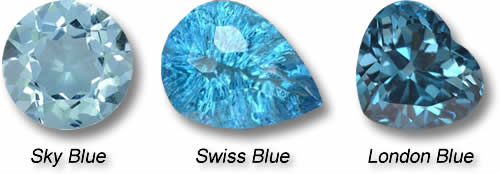
Citrine, a member of the quartz family, is found in yellow and orange tones, the most famous of which is Madeira Citrine, a golden-yellow variety.

The history of Citrine:
Citrine is one of the most well-known gemstones in the history of the quartz family. The name citrine, initially referred to as yellow quartz, was officially adopted in the year 1556, when it was cited by the German metallurgist named Georg Bauer in a reputed jewelry and gemstone publication. In all probability, the name was derived from the Latin term citrus (the citron tree), or the Old French term citrin (lemon-colored). Of course both words are related to the imagery of citrus fruits, often found in yellow and orange tones.
Citrine has been used in jewelry and tools for several centuries. It became extremely popular in Ancient Greece, where it was used as a decorative gem on a wide scale.
Citrine was also used by Scottish weapons manufacturers during the 17th century, to decorate dagger handles, in particular. Afterward, citrine gained popularity in making conventional Scottish shoulder brooches, as well as kilt pins. Citrine's popularity at that time was mainly due to the fact that Queen Victoria loved this gem immensely.

Citrine once more became well-known during the Art Deco period in the early 20th century. The extensive coloring, as well as the versatility of citrine, proved to be a fantastic match for the visual aesthetic that characterized the Art Deco movement, which encompassed everything from apparel to jewelry, interior design and furniture.
During the 1930s, there was a huge demand for citrine that a number of lapidaries (people who process gemstones) relocated from Idar-Oberstein (a leading European center of gem cutting) in Germany to South Africa, where the stone is found in good quantities. Huge amounts of citrine were shipped from South Africa to Europe to be cut, polished and fashioned into jewelry and other ornaments. Large, rotating sandstones were employed by these craftsmen in order to cut the citrine into outstanding pieces, similar to what they had been doing with other varieties of quartz.

You will find citrine almost everywhere on the planet, but it is particularly common in regions that also have large deposits of amethyst, such as Brazil. Some may mistake heat-treated Brazilian amethysts for citrines, as the purple-colored amethyst crystals become golden-brown once exposed to extreme heat at length. Although the top producer of citrine happens to be Brazil, it is also found in Bolivia, Uruguay, Madagascar, Scotland, Namibia, Spain, Russia, Argentina, Myanmar, as well as the US.
Citrine is available in different sizes and shapes. The finished stones can be either shaped and polished or faceted. You can find many types of stunning jewelry that feature citrine. An extremely versatile gemstone, citrine can accommodate any style of November birthstone jewelry you wish.
The history of Topaz:
According to gemstone authorities, the November birthstone name topaz has been derived from Topazios, an Old Greek name given to a small island, known today as Zabargad, in the Red Sea.
Although topaz was never found on that island, at one time it produced an abundance of peridot, which was actually confused with topaz prior to the advancement of contemporary mineralogy. Some historians even trace the etymology of topaz back to a Sanskrit (India's ancient language) root, tapas, which means "heat" or "fire".
According to the ancient Greeks, topaz provided them with immense strength and vitality. Individuals in Europe (from the 1300s right up to the 1600s) were of the notion that topaz could remove feelings of anger, as well as dark magic spells. Those who lived in India during the last few centuries believed that if they wear topaz above their heart, it will ensure long-term beauty, long life, as well as a high aptitude.
In these modern times, there are still many people who believe that they can protect themselves from black magic by wearing a topaz amulet on their arms.
Moreover, topaz is thought to help people to calm down, behave sensibly, get rid of nightmares, and so forth.
In any event, topaz goes on attracting individuals even today. One can wear the stone fashionably in a ring, broach, necklace, or even earrings.
The meaning of citrine:
The primary reason for citrine's immense popularity was a lack of inexpensive gold gems, which are quite attractive to people who believe that gemstones, such as citrine, channel the sun's power and all the positive aspects that are related to it. Many people are of the notion that citrine will help to enhance their mood, as does the light and warmth of the sun, and they will be able to appreciate their surroundings, which is ideal for November, the month of Thanksgiving.
The meaning of topaz:
Topaz, which actually symbolizes affection and love, is believed to offer strength, as well as intelligence to anyone who puts it on. Moreover, a gift of blue topaz will convey your love and devotion to that special someone.
Topaz's healing properties:
Topaz is quite effective when it comes to manifesting good health and well-being, as well as fixing any specific issues within our bodily systems. Topaz is fantastic for our nervous and digestive system, as well as for stimulating metabolism. According to some, topaz will help significantly with any eating disorders, particularly anorexia. While used in the form of an elixir, this November birthstone has the ability to disperse energy throughout the body.
Topaz was used extensively in the past by individuals to treat disorders of the eye and mental health issues, such as depression and anxiety. It is also possible to use it to alleviate cardiac pains, as well as significantly improve our taste.
Topaz will be one of the most effective stones when it comes to healing our emotional well-being.
A highly active gemstone, topaz will teach us about forgiveness and truth, as it transforms negative feelings into good faith and hope.
Citrine's healing properties:
Citrine has the reputation of being amongst the most effective supporters of energy and stamina, particularly when it comes to our endocrine system. This amazing gemstone will also boost our metabolic processes, plus help to reverse any degenerative disease. While balancing the thyroid, citrine will likewise prevent it from growing whatsoever.
Citrine is fantastic for stimulating our digestive system, the pancreas and the spleen. It will also help to reduce, or even prevent, any skin or hair problems, allergic symptoms, or any other problem linked to the usage of chemicals.
Citrine's durability:
As a variety of quartz, citrine has a Mohs hardness rating of 7, which protects it against scratches from other varieties of quartz, and other gemstones such as amethyst (Mohs 7), opals (Mohs 5.5 - 6.5), and some varieties of zircon (Mohs 6.5 - 7.5). Quartz is actually seen as a low-end benchmark for hardness because of the inescapable presence of quartz all over the world. Not only is it found in large mineral deposits, where we mine citrine and amethyst, for example, but it is also a very fine airborne particulate that makes up a great deal of the dust that settles on jewelry, and may be errantly wiped away, causing scratches to material that is lower than 7 on the Mohs hardness scale.
As quartz is such a large and diverse class of mineral, it is important to remember that not all quartz are equal in their hardness due to the likely presence of impurities in the specimen. If, for example, a piece of citrine contains relatively high amounts of iron, it will have a lower hardness. This is true for all gemstones: impurities lower the overall durability of the specimen. However, impurities are typically what give some transparent gemstones their color; so, they are not always negative.
Though citrine is relatively hard, it does have limitations with regard to its toughness (resistance to chipping and cracking) and stability (resistance to chemical and environmental attack). The tenacity (or toughness) of citrine is considered brittle, though that characteristic has broad types that range from poor (very low toughness) to exceptional (very high toughness). Citrine has good toughness - right in the middle of the spectrum.
Citrine is sensitive to thermal shock (abrupt changes in temperature) and can fracture fairly easily in this condition. Any prolonged exposure to intense light can cause citrine’s color to fade. Also, alkaline chemicals, such as hydrofluoric acid and ammonium fluoride (substances found in rust removers and metal polishes), can damage citrine gemstones.
Overall, the durability of citrine requires caution, though citrine jewelry can be worn every day with appropriate care. Still, it may be prudent to save citrine rings and bracelets for special occasions only.
Citrines make excellent center pieces for rings and are often used as such. It is also not uncommon to see a citrine engagement ring, especially if the bride-to-be has a November birthday.
Citrines are also used extensively in tennis bracelets; nonetheless, citrine rings and bracelets should be worn with a bit of caution to avoid hard surfaces and other sources of shock. Citrine is a perfectly safe gemstone to use in earrings and pendants, as these pieces are unlikely to encounter rough conditions.
Topaz's durability:
Topaz enjoys a considerably higher degree of durability than citrine, starting with its place at 8 on the Mohs hardness scale. This puts it in league with such gemstones as emerald (Mohs 7.5 - 8) and spinel (Mohs 8).
Despite this high hardness rating, topaz has a poor toughness, due to its perfect cleavage, which makes it very easy to cut and, therefore, requires a great deal of care so as not to cut - or break - it accidentally.
As a result of this poor rating, jewelry designers avoid placing topaz in rings and, if they do, it is usually done in a protective mounting with a lot of metal. Topaz is more often found in pendants and pins - pieces that are unlikely to encounter mechanical shock.
Topaz has a very good stability and, though it is vulnerable to thermal shock, which can cause it to fracture, its color is stable and its surface is generally unaffected by chemicals. Overall, topaz would, however, be considered less durable than citrine; so if it is a birthstone engagement setting you are looking for, citrine would be more suitable for such a high mounting and everyday use.
Warm, soapy water and a soft brush is the safest way to clean both topaz and citrine. While ultrasonic and steam cleaners should never be used to clean topaz, due to its instability in high temperatures, citrine may be cleaned with an ultrasonic cleaner, though not a steam cleaner. This is especially recommended for citrine that have been dyed or fracture-filled; in this case, neither steam cleaners, nor ultrasonic cleaners, should be used to clean citrine.
When storing your citrine and topaz jewelry, take care to keep them in separate compartments of a fabric-lined jewelry box. Make sure that these jewelry pieces cannot scratch, chip or break softer gemstones, or incur damage from harder ones. Also keep your jewelry box in a cool and dry place.
A common, space-saving method of storing gemstones is to place them in acid-free paper envelopes, stored in a parcel paper organizer box. These are often referred to as gemstone parcels or diamond papers. Another approach, which allows you to showcase your birthstone jewelry as you keep it safe, is to use glass or acrylic jars with foam inserts.
Always remove your November birthstone jewelry before doing physical work around the house or back yard, as well as before exercising, swimming or bathing, applying makeup or fragrances, and using any caustic cleaning chemicals. Though both November birthstones, topaz and citrine, are relatively hard gemstones, they both have weaknesses that make it sensible to just avoid any physical or chemical shock with either one.

Loose citrine are remarkably affordable and can be purchased for as little as $3 each for a 0.5 carat, untreated Brazilian golden citrine, sized 8 x 4 mm. These would make a very nice (and cheap!) set of earrings. Even some of the largest available citrine won't set you back too much. Consider a 26 carat, octagonal emerald cut, untreated Brazilian golden citrine, sized 20 x 15 mm - perfect for a fancy cocktail ring - for just under $200.
Conversely, topaz can be fairly expensive at the high end, though relatively the same as citrine at the low end, especially for white topaz. If you are after something more colorful, a pair of oval or square pink mystic topaz earrings are sure to grab anyone's attention. Have a look at a set of 6 carat, square princess cut, pink mystic topaz from Brazil, sized 10 x 10 mm each, for $90. Anyone looking to design a piece of November birthstone jewelry to remember can go all-out with a 5.5 carat, pear orange Brazilian Imperial Topaz, sized 16 x 7 mm - ideal for a pendant - for $3,000.
There are actually as many as ten different stones that fall into the category of November birthstones when considering planetary associations, relationships to the sun and other stars, or talismanic stones for Sagittarius and Scorpio.
From as far back as the 15th century to the early 20th, pearl was considered appropriate for a November birthstone, along with topaz and citrine. The zodiac signs of Sagittarius and Scorpio include seven additional gemstones: aquamarine, beryl, amethyst, garnet, ruby, sapphire, and turquoise.
Citrine and topaz both offer lovely options for November birthstone jewelry without breaking the bank. Although topaz is harder than citrine, both stones have relatively similar durability and can be used in any type of jewelry setting; though it is recommended that topaz be reserved for special occasions, due to its tendency to chip and break. If you want to wear your November birthstone jewelry every day, citrine is the sensible choice for rings and bracelets.
Both of these fantastic November birthstones have a history rich in physical and spiritual healing, as well as cultural importance. Anyone who wears topaz, citrine, or both, will be sure to not only enjoy their birth month, but to lead a happy, healthy and successful life, as well. Add some November birthstone jewelry to your collection, or give it to a loved one, today!


